There have always been thin watches, and always watchmakers who have dedicated their craft to reduce the essentials of timekeeping, as well as other additional complications, into as slimmed down and wearable a package as humanly (and horologically) possible. Lately, however, as 21st century technological developments impact watchmaking as they have every other industry, it seems there are more exceptionally thin watches than ever before —some of them aimed at a customer simply seeking an elegantly understated and luxuriously lightweight timepiece for regular wear, others almost defiantly unobtainable to all but a few, but intended to boldly shatter records for both thinness and complexity. We offer some of both types in our roundup of ultra-thin watches below (which we're defining as 10mm thick or under, based on average watch sizes), in ascending order of case thickness, starting from the top with the current category record holders.
Under 2mm
Richard Mille RM UP-01 Ferrari (1.75mm)
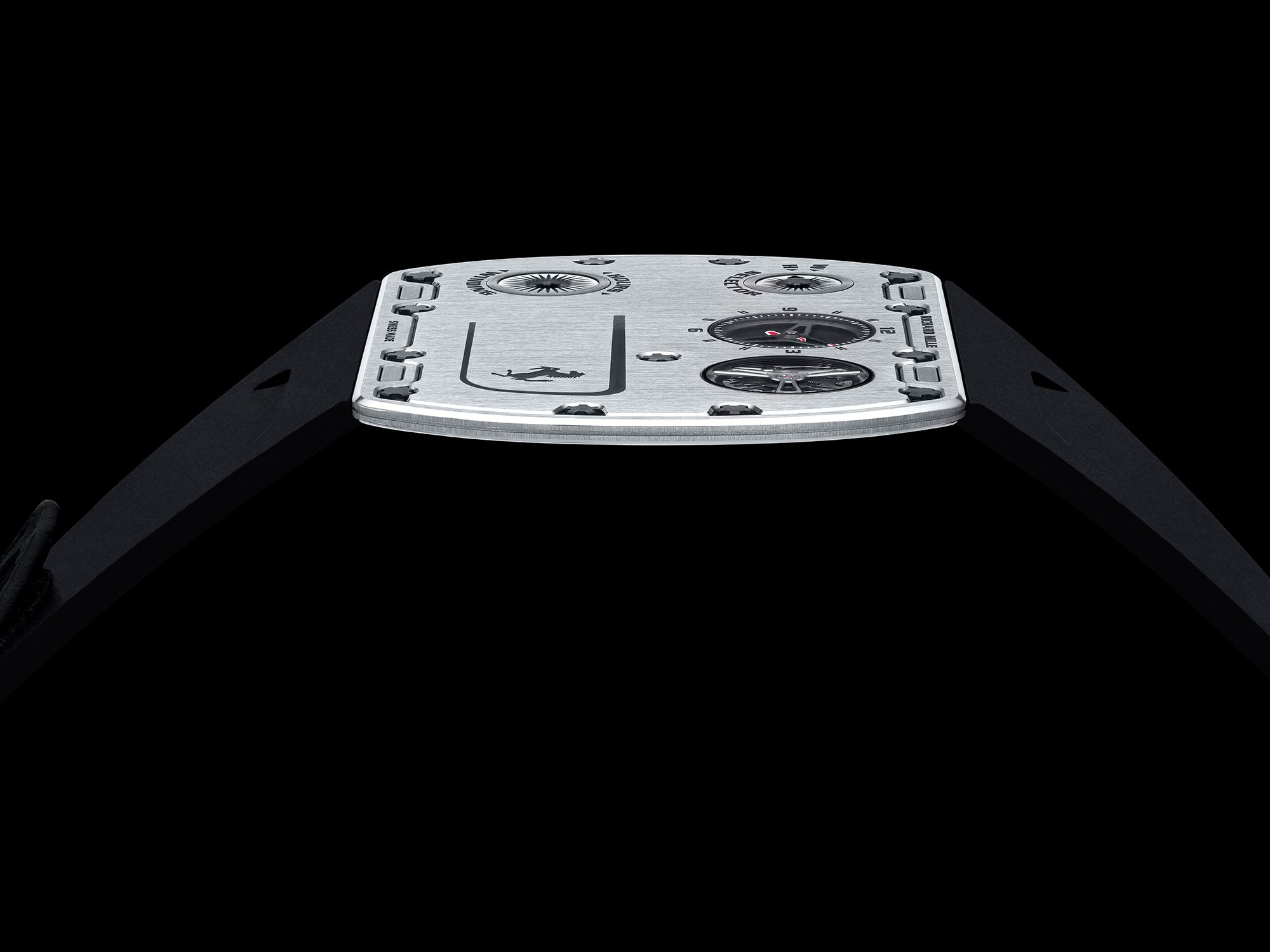
In the world of high horology, Richard Mille has been pushing the envelope in the areas of materials, technologies, and (let’s face it) prices for quite some time. In 2022, the brand probably best known for making the watch that tennis champ Rafael Nadal wears to play in Grand Slams entered a new partnership with Ferrari, and the result was, to many watch enthusiasts’ surprise, the current record-holder for world’s thinnest watch. The RM UP-01 Ferrari is an almost unimaginable 1.75mm thick, with a movement just 1.18mm thick. The product of multiple years of R&D and dozens of prototypes, the watch has a titanium case weighing only 2.82 grams yet still offering exceptional rigidity. The movement, assembled inside the case, features an extra-flat barrel with a super-fine hairspring and a patented ultra-flat escapement, with a variable inertia balance in titanium that allows for fine tuned calibrations. A traditional winding crown with a stem is replaced by two crowns integrated into movement wheels — one for winding, the other for function selection — which are operable from the front. The hands are directly affixed to wheels and protected under sapphire crystals slimmed down to 2/10th of a mm in thickness. The 150-piece limited edition is priced for Ferrari owners: $1.88 million.
Bulgari Octo Finissimo Ultra (1.8mm)

Frankly, a list of the type could be assembled solely with watches from Italian watchmaker-jeweler Bulgari, which has made ultra-thin watches its stock-in-trade for the better part of a decade and has set or broken multiple records in its Octo Finissimo series. In 2022, the brand introduced the Octo Finissimo Ultra, whose astonishingly slender 1.80mm case was only ever-so-slightly edged out of the “world’s thinnest watch” top spot by Richard Mille’s contender above. Nevertheless, the watch is a marvel of technical engineering, with the back of the 40mm octagonal case serving as the movement’s baseplate and the integrated bracelet boasting the same thinness as the watch as well as the same sandblasted finish. In profile, the timepiece is barely thicker than a sheet of paper. Joining the regulator-style hours and minutes display and off-center seconds on the dial is an engraved QR code on the ratchet wheel — a watch-world first — that connects the watch’s owner (there will be only 10) to an exclusive piece of NFT artwork and a plethora of extras, including a virtual 3D tour of the movement. The case combines titanium and tungsten carbide with an anthracite DLC treatment; the movement, Bulgari’s BVL Caliber 180, stores 50 hours of power reserve in its large barrel and includes two horizontally placed knobs for winding and setting to replace a traditional stem-mounted crown. This extremely limited watch sells for $440,000.
Bulgari Octo Finissimo Ultra Tourbillon (1.85mm)

On the heels of the major milestone it achieved with the timepiece showcased directly above this one, Bulgari could not resist upping the ante on both design and level of complexity in 2025 with the much-heralded launch of the Octo Finissimo Ultra Tourbillon. Coming in at a razor-thin 1.85mm — yes, just .05 thicker than the time-only Ultra — the watch takes the coveted title of the world’s thinnest tourbillon watch, leaving some very impressive previous claimants to that title (you’ll discover them further down the list) in the dust. The case is 40mm wide, with its main parts made from microbead-frosted titanium, and incorporates two planar “crowns” at 3 o’clock and 8 o’clock to set the time and wind the movement, respectively. Mounted on a mainplate of tungsten carbide, the manually wound Caliber BVF 900 not only features a traditional two-handed time display (in contrast to the regulator style of its predecessor) but also a skeletonized architecture, with a rhodium-plated balance and bridge for the “flying” tourbillon escapement. The integrated bracelet, another hallmark of the multiple-award-winning Octo Finissimo series, is made of the same microbead-frosted titanium and is even thinner than the case, rising just 1.5mm above the wrist. Fully eight patents have been secured for this model, which is limited to 20 pieces, each priced at $678,000.
Piaget Altiplano Ultimate Concept (2mm)

Filling out the quartet of unearthly thin timepieces at 2mm or under is Piaget’s Altiplano Ultimate Concept, introduced as a prototype in 2018 and finally released as a commercial product in 2020; at the time it held the coveted title of the world’s thinnest mechanical watch. At a case thickness of just 2mm, the Altiplano Ultimate Concept matched the thickness of Piaget’s groundbreaking Caliber 9P (more on which below), introduced as the world’s thinnest watch movement back in 1957. The case is made of an alloy of cobalt that’s exceptionally durable as well as lightweight and shock-resistant. Winding is achieved via a single “infinite screw,” operated by a special tool, rather than a traditional sliding pinion and crown wheel system, which increases shock resistance. The dial with its exposed movement parts lies under a sapphire crystal that’s 80 percent slimmer than the norm, just 0.2mm thick. The hours-and-minutes subdial at 12 o’clock is accompanied by several of the movement’s vital parts on frontal display, including the drumless mainspring barrel and a balance wheel, as well as the inner workings of the winding mechanism. Many of the watch’s elements are customizable, such as the color of the finish on the hands and the exposed mainplate. Price is on request.
Under 3mm
Citizen Eco-Drive One (2.98mm)
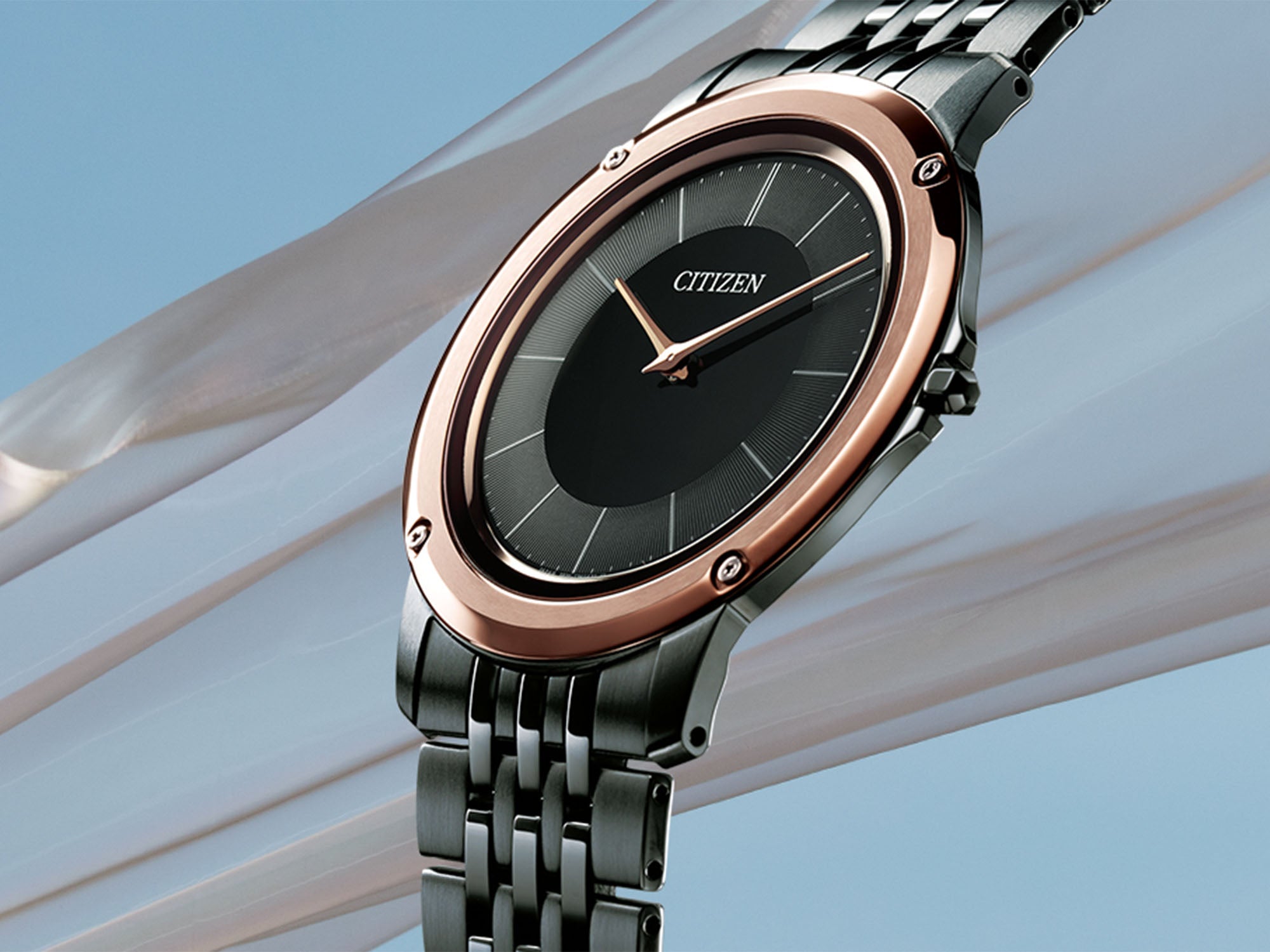
The Citizen Eco-Drive One marked the 40th anniversary of the brand’s proprietary Eco-Drive technology in 2016 and remains the world’s thinnest light-powered analog watch. Its case, made of a ceramic composite material called cermet, is 38.15mm in diameter and just 2.98 mm thick, with a bezel made of cemented carbide, a material boasting extreme hardness as well as high corrosion- and oxidation-resistance. Its Eco-Drive movement, which Citizen says required a total redesign of the original, comes in at just 1.00 mm thick and still claims an accuracy of +/-15 seconds per month. The movement also consumes less energy than its thicker predecessors, enabling the watch to run for 10 months on a single full charge from any light source. Citizen has priced the Eco-Drive One at $3,995.
Under 4mm
Piaget Altiplano 900P (3.65mm)

Piaget is one of the true horological pioneers when it comes to super-slim watches and movements, going back all the way to 1957 with the introduction of its Caliber 9P, then the world’s thinnest mechanical movement at just 2mm thick. It was the first of many such slender movements over the coming years, an area of watchmaking for which Piaget has become well known. With the Altiplano 900P, introduced in 2013, the maison set its sights on creating the world’s thinnest mechanical watch by employing a bold, somewhat radical engineering solution: essentially merging the caliber with the case, i.e. machining the entire movement’s mainplate out of the caseback. This solution, which ensures that the case and movement are one and the same, and thus that the latter cannot be removed from the former for adjustments, gives the watch its extraordinary thinness of 3.65mm. In this world’s-first construction, the bridges and wheel train are visible on the watch’s dial side, with one of the bridges holding a single suspended barrel for the mainspring, and the hands affixed directly to wheels and placed beneath the level of the bridges to save space under the crystal. Prices start at $34,000.
Under 6mm
Breguet Classique Extra-Thin 5157 (5.4mm)
 Breguet’s founder, Abraham-Louis Breguet, invented the tourbillon and the modern-day brand can claim its own milestone in the area of ultra-thin tourbillon watches, 2014’s Classique Tourbillon Ultra-Plat Automatic 5377, which held the "world’s thinnest" title in the tourbillon category for a while. However, Breguet can also do both extra-slim and classically simple and wearable, as with the timepiece spotlighted here, the Classique Extra-Thin 5157. The rose-gold case combines a modest 38mm diameter with a very slim 5.4mm thickness. Its narrow bezel frames a wide, elegantly appointed dial, with blued Breguet hands (that’s right, the founder invented their distinct shape also), subtle black Roman numerals for the hours, and a hand-engraved hobnail guilloché pattern. The movement inside is Breguet’s manufacture Caliber 502.3, with an off-centered solid-gold rotor bearing its own eye-catching guiulloche finish. In addition to a host of other haute horlogerie decorations, including côtes de Genéve on the bridges and mainplate, this self-winding caliber is noteworthy for avant-garde technical details like its magnetic-resistant silicon balance spring. Prices for the Classique 5157 start at $18,700.
Breguet’s founder, Abraham-Louis Breguet, invented the tourbillon and the modern-day brand can claim its own milestone in the area of ultra-thin tourbillon watches, 2014’s Classique Tourbillon Ultra-Plat Automatic 5377, which held the "world’s thinnest" title in the tourbillon category for a while. However, Breguet can also do both extra-slim and classically simple and wearable, as with the timepiece spotlighted here, the Classique Extra-Thin 5157. The rose-gold case combines a modest 38mm diameter with a very slim 5.4mm thickness. Its narrow bezel frames a wide, elegantly appointed dial, with blued Breguet hands (that’s right, the founder invented their distinct shape also), subtle black Roman numerals for the hours, and a hand-engraved hobnail guilloché pattern. The movement inside is Breguet’s manufacture Caliber 502.3, with an off-centered solid-gold rotor bearing its own eye-catching guiulloche finish. In addition to a host of other haute horlogerie decorations, including côtes de Genéve on the bridges and mainplate, this self-winding caliber is noteworthy for avant-garde technical details like its magnetic-resistant silicon balance spring. Prices for the Classique 5157 start at $18,700.
Patek Philippe Golden Ellipse (5.9mm)

The Golden Ellipse, launched in 1968, is Patek Philippe’s second oldest existing model behind the Calatrava. Its odd elliptical case, combining elements of an oval and a rectangle, took its influence from the “golden mean” of ancient Greek mathematicians and the basis of numerous artistic and architectural masterpieces throughout history. For its 50th anniversary in 2018, Patek launched two new versions of the cult-classic model, one in platinum, the other in 18k rose-gold, each with a svelte wrist profile of just 2.53 mm thick. The sunburst-finished enamel dial features hands and hour appliqués in either white gold or rose gold. Inside the 34.5mm x 39.5mm case of both timepieces is Patek’s manufacture Caliber 240, an ultra-thin automatic movement with an 18k gold microrotor and a minimum 48-hour power reserve that made its debut in a Golden Ellipse watch in 1977. The Golden Ellipse carries an MSRP of $36,670.
A. Lange & Söhne Saxonia Thin (5.9mm)
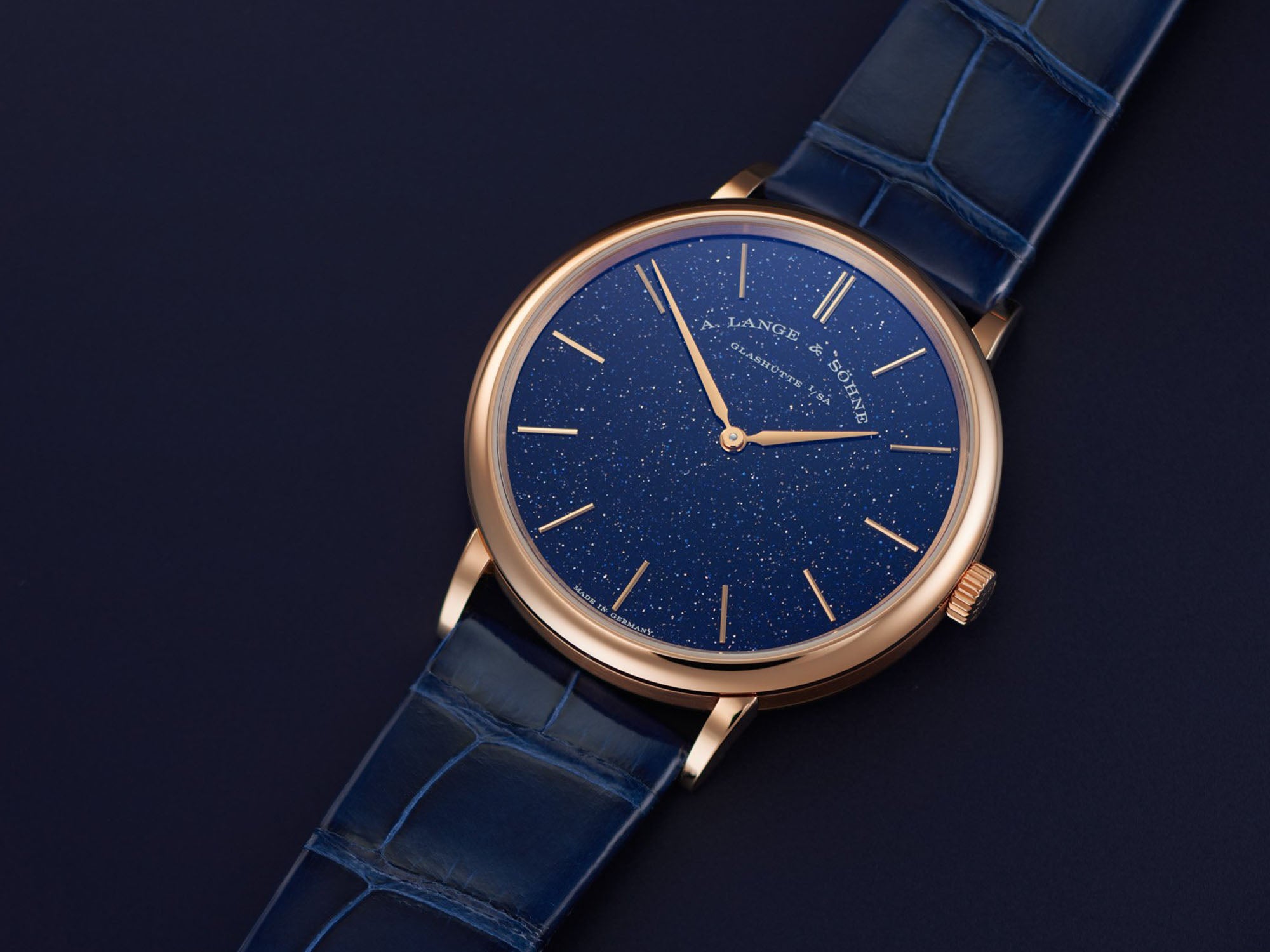
The Saxonia family is one of the very first collections introduced by the revived A. Lange & Söhne company at its launch in 1994; the watches’ classically proportioned, elegant aesthetic is envisioned as a tribute to the legacy of watchmaking in the German state of Saxony, for which they are named. The Saxonia Thin model, launched in 2011, embodies discrete luxury with its 40mm case that measures only 5.9mm thick. It’s not only Lange’s thinnest timepiece but also one of its most clean and straightforward in design: just the essential elements for timekeeping, including two lancet hands, simple baton hour markers, and a subtle, peripheral minute scale on the silver dial. The movement inside is Lange’s manually wound Caliber L093.1, itself a paragon of slimness at just 2.9 mm thick and endowed with numerous details of traditional Saxon watchmaking including a three-quarter mainplate, made of German silver and enhanced with Glashütte waves; gold chatons secured with thermally blued screws; and a balance cock with a hand-engraved finish. The Saxonia Thin is presented on a shiny black leather strap and retails for $25,800.
Tissot T-Classic Tradition 5.5 (5.2mm)

Tissot thrives on offering affordable timekeepers in just about any style for just about any type of wearer — from sporty divers to motorsport-infused chronographs to sober dress watches suitable for both office and evening recreation. The T-Classic Tradition 5.5 is not only vintage-influenced in is design, with a simple sword handset and thin, elegant Roman numeral hour markers, but also elegantly understated in its dimensions: the steel case is a very wearable 40mm in diameter and a svelte 5.2mm thick. Inside the case, behind the guillioché-decorated dial, is a Swiss-made quartz movement from ETA. The 30-meter water resistant watch comes on a sleek, black alligator-style grained cowhide strap with a butterfly clasp. At about $375, it's also the most obtainable watch on this list.
Audemars Piguet Royal Oak Selfwinding Perpetual Calendar Ultra-Thin (6.3mm)

One doesn’t always think of Audemars Piguet’s iconic Royal Oak (which turned 50 years old in 2022) when the subject of ultra-thin timepieces comes up, but the fact is that the original 1972 “Jumbo” was as radical at the time for its slender silhouette as for its trend-setting case and dial elements. Audemars Piguet has carried that spirit forward into some of today’s high-complication versions of the Royal Oak, most notably the Royal Oak Selfwinding Perpetual Calendar Ultra-Thin, which at just 6.3mm thick became the world’s thinnest automatic perpetual calendar wristwatch until it was overtaken by (guess who) Bulgari, with its own 5.8mm model. The watch, whose case combines titanium and platinum and features the emblematic octagonal bezel and grand tapisserie textured motif on the dial, won the Aiguille d’Or grand prize at watchmaking’s Oscars, the Geneva Grand Prix, in 2019. The thickness of its super-complicated movement, Caliber 5133, was achieved partly by AP’s watchmaking engineers condensing the three levels of mechanisms common to most perpetual calendar movements into a single level, i.e., combining multiple functions into single mechanisms like fusing the month wheel and month cam — the result of more than five years of research and development. All in all, the sticker price of $293,000 shouldn't be a shocker.
Bulgari Octo Finissimo Minute Repeater (6.85mm)

As part of its parade of record-breaking, ultra-thin complications, Bulgari unveiled the Octo Finissimo Minute Repeater in 2016, initially in a titanium case and afterward in a rose gold one. With this spectacular and exceedingly rare timepiece, Bulgari set out to create the world’s smallest chiming watch, a challenge because of the amount of interior space usually needed for sound diffusion inside the case. The movement Bulgari’s watchmakers developed, BVL Caliber 362, measures just 3.12 mm thick and fits inside a 40-mm case that is also wafer-thin at 6.9 mm (in rose gold; the titanium case is slightly thinner at 6.85 mm). Among the other technical and aesthetic breakthroughs achieved by Bulgari’s watchmakers were the cut-out hour-markers on the dial, which bears the same sandblasted finish as the case for a harmonious, monochromatic look; and the cut-out ring around the small seconds subdial at 6 o’clock, both of which cleverly established openings that serve to amplify the resonance inside the case and thereby optimize the sound effect. The sound-producing gongs are directly affixed to the case and finished by hand, and the 9 o’clock pusher activating the striking mechanism is equipped with an “all or nothing” safety device that helps maintain the watch’s 50-meter water resistance, a rarity in a minute repeater. As one might expect, it's both limited (50 pieces) and expensive ($160,000).
Cartier Drive de Cartier Extra Flat (6.6mm)

Cartier’s Drive de Cartier series, launched in 2016, carries on some of the enduring and iconic design codes of the watch-and-jewelry house’s older product families such as the Tank and Santos — Roman numeral hour markers, railroad minute track, sword-shaped hands, an octagonal cabochon-tipped crown — and applies them to a distinctive cushion-shaped case. The original Drive models are fairly slender in profile, at 11.25mm, but the Extra-Flat models, rolled out to expand the collection in 2017, are notably even thinner: just 6.6mm, slimmed down by a factor of 40 percent. The case diameters are also very wrist-friendly at 38mm x 39mm, though not necessarily wallet-friendly as they’re mostly in rose gold or white gold. Cartier’s hand-wound, ultra-thin Caliber 430 MC, which uses the Piaget Caliber 430P as its base, ticks inside the case, measuring just 20.5mm in diameter and a wafer-like 2.1 mm thick and storing a power reserve of 43 hours. Prices start at $5,600.
Nomos Tangente 35 (6.6mm)

The Nomos Tangente, the flagship collection of one of Germany’s youngest watch brands, has scooped up multiple design awards for its eminently clean, Bauhaus-inspired aesthetic. It was first conceived in 1992 by Nomos founder Roland Schwertner and resurrects an ahead-of-its-time dial design from the 1930s (the heyday of the Bauhaus movement), complete with a typeface typical of that era. Today, the Tangente, referred to by the company as “the round watch with the right angles,” is offered in a number of sizes and executions, the most understated being the 35mm model with a wisplike thinness of 6.6mm. The watch has a galvanized, silver-plated dial with traditional, central hours and minutes hands and a small seconds subdial at 6 o’clock. Giving it life inside the case is Nomos’ in-house manually wound Alpha caliber, with a stop-seconds mechanism, Incabloc shock protection, a Nivarox balance spring and blued screws. The three-part steel case is fitted with a sapphire caseback to show off the Alpha caliber and is mounted on a genuine Horween shell cordovan leather strap. The Tangente 35 is priced at a tempting $2,180.
Under 8mm
Jaeger-LeCoultre Hybris Mechanica 11 (7.9mm)

Another immensely complicated timepiece that nevertheless set new thinness records when it was introduced in 2014 — a big year for slimmed-down complications, apparently — is Jaeger-LeCoultre’s Master Ultra-Thin Minute Repeater Flying Tourbillon, aka the eleventh masterpiece in its Hybris Mechanica series of horological milestones. It held the record for the thinnest repeater watch for a time and even more impressively managed to also include a flying tourbillon and automatic winding via a peripheral rotor. Its ultra-complex movement measures just 4.8mm thick and the case that houses it is a mere 7.9mm thick, at a diameter of 41mm, an unprecedented size for such a complicated timepiece. The watch boasts several horological firsts, many of them patented, including the retractable push-button that activates the repeater mechanism, which returns to its recessed position after being triggered to maintain the case’s smooth silhouette. Others include the locking system at 8 o’clock that secures the push-button when not in use, the tourbillon’s patented flying balance wheel, and the repeater mechanism’s silent-time-lapse reduction system that eliminates pauses between chimes. All in all, Jaeger-LeCoultre obtained eight patents for the Hybris Mechanica 11, a limited edition of only 75 pieces priced around $400,000.
Under 10mm
Vacheron Constantin Patrimony Contemporaine Ultra-Thin Calibre 1731 (8.09mm)

Before Bulgari came along with its Octo Finissimo, Vacheron Constantin boasted the world’s thinnest minute repeater, the Patrimony Contemporaine Ultra-Thin Calibre 1731, whose rose-gold case spanned just 8.09 mm in profile and its movement, just 3.9 mm in thickness. Caliber 1731, named for the birth year of brand founder Jean-Marc Vacheron, amasses a lengthy 65-hour power reserve and beats inside a pebble-shaped rose-gold case based on an ancestor from 1955. The bezel and sapphire crystal are both curved, and the understated dial has a beaded minute circle, baton-shaped hands and applied hour markers in rose gold, and an unusual off-center small-seconds subdial at 8 o’clock. In addition to its extraordinary thinness, integrated chiming function, and impressive power reserve, the movement incorporates a flying strike governor, an innovative device that controls the speed and spacing of the repeater’s chiming tones and reduces the audible whirring sounds that can accompany the chimes. Like most other Vacheron Constantin in-house calibers, this one carries the prestigious Hallmark of Geneva, attesting to its elite level of finishing. The watch comes in a rose gold case and retails for $369,300.
Arnold & Son UTTE (8.34mm)

Arnold & Son, a prestigious, Swiss haute horlogerie brand named for legendary British watchmaker John Arnold, is no stranger to innovative tourbillon timepieces, and in 2013 the company, now owned by Japan’s Citizen Group, held the title for thinnest tourbillon watch on the market. The Arnold & Son UTTE (the initials are for “Ultra Thin Tourbillon Escapement”), staged an impossibly thin flying tourbillon caliber — just 2.97mm thick — inside a precious metal case whose diameter was a substantial 42mm but whose thickness was a super-slim 8.3mm. The manually wound movement, Caliber A&S200, whose tourbillon cage actually rises slightly above the stated 2.97mm thickness to become a presence on the dial, also stores a 90-hour power reserve in its two barrels. The original UTTE was available in a rose gold or palladium case with a silvered white guilloché dial; subsequent versions included one with a skeletonized version of the tourbillon movement and several with lacquered and Tahitian mother-of-pearl dials. Their prices start around $26,500.
Blancpain Villeret Ultraplate (8.7mm)
 Blancpain’s Villeret collection is named for the Swiss village where the historical manufacture was founded way back in 1735, and distinguished by classical design elements of earlier eras. The first Villeret models emerged in the 1980s, back when most other heritage Swiss watch manufacturers were either hibernating or struggling through the Quartz Crisis, and the collection continues to expand to this day, now encompassing an array of styles and complications. On the simpler side is the three-hand-date version of the Villeret Ultraplate subfamily, which features all the hallmark Villeret design details: a double-stepped bezel; openworked sage-leaf-shaped hands; a central seconds hand with a “JB” counterweight (those are the initials of brand founder Jean-Jacques Blancpain); and applied Roman numerals for the hours on the sunray-finished dial. In keeping with its name (“ultra plate” means “ultra flat”), the watch’s 40-mm rose-gold case is just 8.7 mm thick. The movement, visible through the sapphire caseback, is Blancpain’s automatic Caliber 1151, whose two series-coupled barrels store an eye-opening 100-hour power reserve, and whose gold rotor is engraved with a honeycomb motif, another Villeret hallmark. Price: $19,400 on leather strap, $38,900 on Milanese-style gold bracelet.
Blancpain’s Villeret collection is named for the Swiss village where the historical manufacture was founded way back in 1735, and distinguished by classical design elements of earlier eras. The first Villeret models emerged in the 1980s, back when most other heritage Swiss watch manufacturers were either hibernating or struggling through the Quartz Crisis, and the collection continues to expand to this day, now encompassing an array of styles and complications. On the simpler side is the three-hand-date version of the Villeret Ultraplate subfamily, which features all the hallmark Villeret design details: a double-stepped bezel; openworked sage-leaf-shaped hands; a central seconds hand with a “JB” counterweight (those are the initials of brand founder Jean-Jacques Blancpain); and applied Roman numerals for the hours on the sunray-finished dial. In keeping with its name (“ultra plate” means “ultra flat”), the watch’s 40-mm rose-gold case is just 8.7 mm thick. The movement, visible through the sapphire caseback, is Blancpain’s automatic Caliber 1151, whose two series-coupled barrels store an eye-opening 100-hour power reserve, and whose gold rotor is engraved with a honeycomb motif, another Villeret hallmark. Price: $19,400 on leather strap, $38,900 on Milanese-style gold bracelet.
Rado True Thinline Anima (9.0mm)
 The use of ceramics in the watchmaking industry has proliferated in recent years but it was Rado that got there first. Starting with the Ceramica in 1986, the first watch with a ceramic case and bracelet, Rado has been pushing the frontiers of what can be accomplished with the lightweight, scratch-resistant materials. A notable recent example is the limited-edition True Thinline Anima, the first ceramic watch with a case made of matte olive green ceramic. The 40mm x 44.8mm monobloc case is also elegantly slender, just 9mm in thickness. The name “Anima,” a Latin word meaning “air,” “breath,” or “soul,” refers to the openness of the watch’s painstakingly skeletonized movement and also to the watch’s overall lightness on the wrist. Based on a standard, automatic ETA A31.L02, the movement has been further customized with bridges made from black anodized aluminum, which reduces weight. In addition to the front view from the dial, the skeletonized movement offers a glimpse of its back side through a sapphire exhibition caseback framed by a titanium ring. The bracelet is made of the same high-tech ceramic as the case and attaches to the wrist via a three-fold clasp made of titanium. The True Thinline Anima is priced at $3,000.
The use of ceramics in the watchmaking industry has proliferated in recent years but it was Rado that got there first. Starting with the Ceramica in 1986, the first watch with a ceramic case and bracelet, Rado has been pushing the frontiers of what can be accomplished with the lightweight, scratch-resistant materials. A notable recent example is the limited-edition True Thinline Anima, the first ceramic watch with a case made of matte olive green ceramic. The 40mm x 44.8mm monobloc case is also elegantly slender, just 9mm in thickness. The name “Anima,” a Latin word meaning “air,” “breath,” or “soul,” refers to the openness of the watch’s painstakingly skeletonized movement and also to the watch’s overall lightness on the wrist. Based on a standard, automatic ETA A31.L02, the movement has been further customized with bridges made from black anodized aluminum, which reduces weight. In addition to the front view from the dial, the skeletonized movement offers a glimpse of its back side through a sapphire exhibition caseback framed by a titanium ring. The bracelet is made of the same high-tech ceramic as the case and attaches to the wrist via a three-fold clasp made of titanium. The True Thinline Anima is priced at $3,000.


















































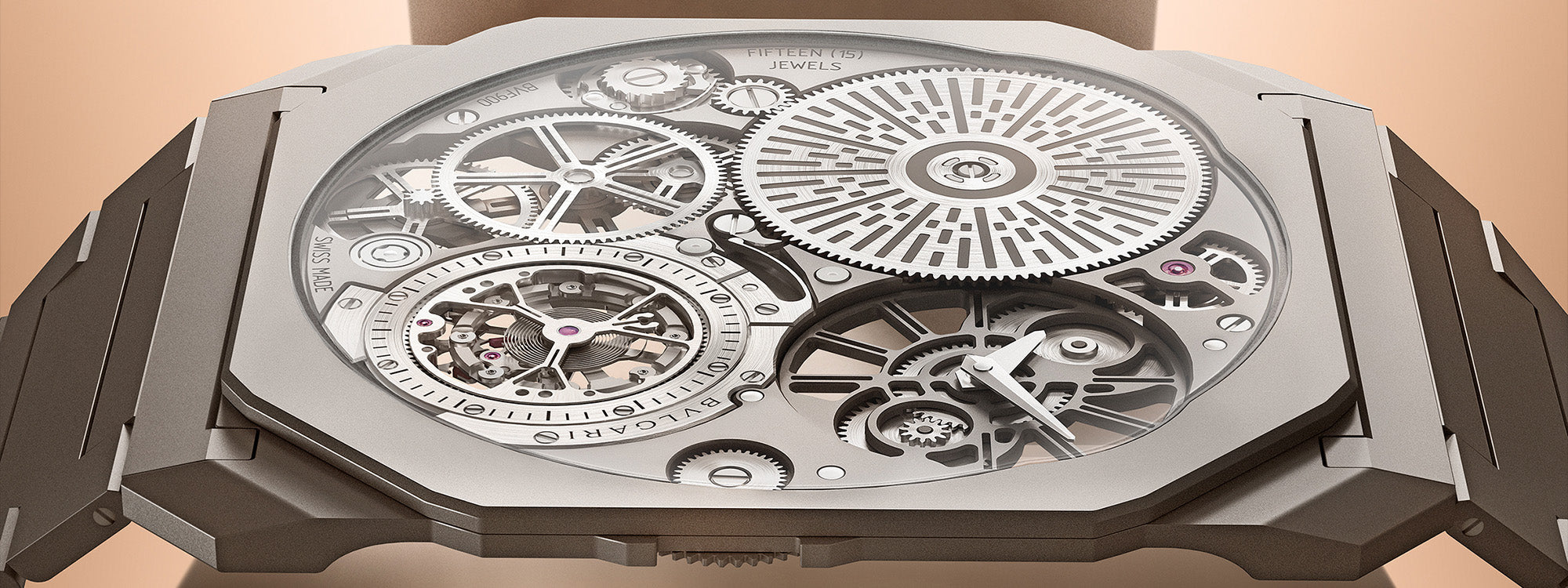



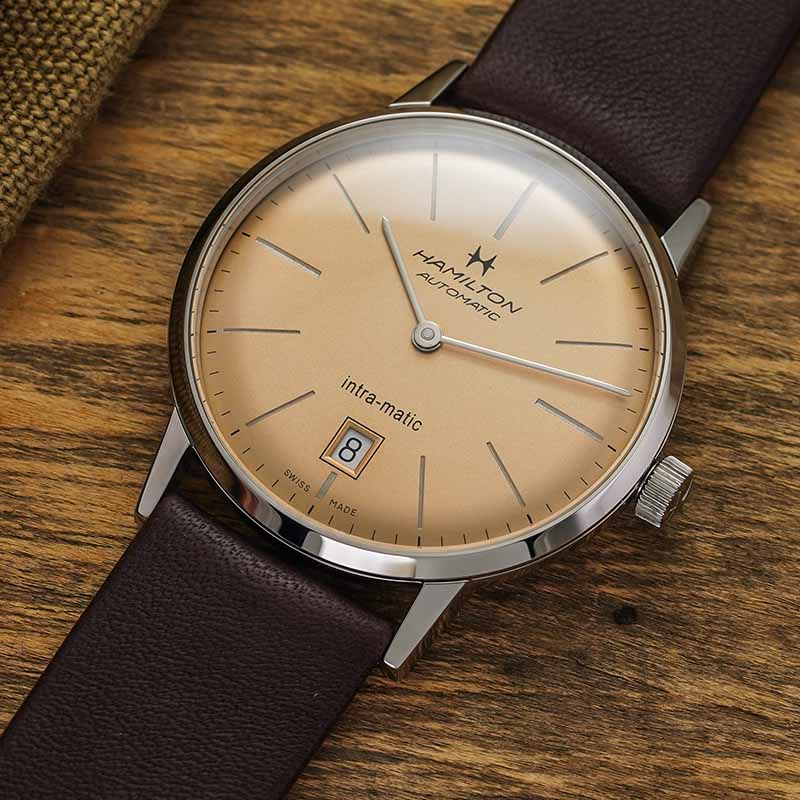






1 Comment
why is zenith elite at 7.3 mm not included